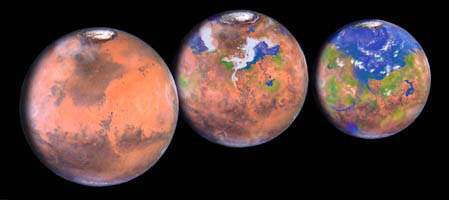
NASA may not be planning to put a human on Mars until the 2030s, but the agency’s top scientist said colonizing the planet is a key part of its agenda – as well as its search for extraterrestrial life.
In a wide-ranging interview with the Guardian, NASA’s chief scientist Dr. Ellen Stofan emphasized that the quest to find alien life is focused primarily on our own solar system, where potential targets include Mars, Jupiter’s moon Europa, and Saturn’s moon Titan. In order to most effectively survey Mars for signs of life, though, Stofan said putting humans on the ground, and establishing a presence there, is a big priority.
In response to a question about whether or not NASA plans to bring back astronauts that reach the Red Planet, Stofan said, “We would definitely plan on bringing them back. We like to talk about pioneering Mars rather than just exploring Mars, because once we get to Mars we will set up some sort of permanent presence."
NASA has expressed such interest before, most recently proposing to send a small greenhouse to the planet in order to experiment with cultivating plant life – something that would be essential to establishing a permanent colony in the future.
Although Mars doesn’t currently seem to be a great habitat for existing life, Stofan argued it’s still possible things may be living beneath the surface – something that can only be explored effectively by humans, not robots.

“Humans can actually read a landscape, go through a lot of rocks – crack them open, throw them, pick up the next one,” she told the Guardian. “Rovers are great, they do amazing science, but it is a lot more tedious process – they go much less far than a human can cover in a day. Having humans on the surface is how I think we are going to be able to demonstrate totally conclusively that life did evolve on Mars.”
Currently, the American space agency is planning to put a human on Mars in 2035 – a plan that depends on the successful completion of a few different missions, as well as stable funding over the course of the next couple of decades. As RT reported earlier this month, a new study by the US National Research Council found that under NASA’s current budget trajectory, reaching the Red Planet would be unlikely.
“Absent a very fundamental change in the nation’s way of doing business, it is not realistic to believe that we can achieve the consensus goal of reaching Mars,” said Mitch Daniels, the former Indiana governor and co-chair of the National Research Council (NRC) Committee on Human Spaceflight.

Stofan downplayed budgetary concerns, however, saying the agency has received “extremely favorable budgets in the last few years” and that tight budgets have inspired innovation at NASA. She also noted that the agency’s asteroid mission – which involves capturing an asteroid and redirecting its orbit around the moon so that astronauts can land on it – is all intended to test technology that would be used on a future Mars mission.
Meanwhile, the contamination of either Earth or Mars remains “a huge concern.”
“First, of all you wouldn't want to bring any weird microbes from Mars to the Earth that could potentially be harmful to people here,” she said. “In the future when we have Mars samples come back, they will go through an incredible procedure basically equivalent to an ebola level quarantine facility to make sure they are not going to contaminate Earth. Then there is contamination of Mars. We are looking for life on Mars so we don't want to carry microbes with us, ‘discover them’ and declare victory.”
Looking elsewhere, the chief scientist added that a visit to Europa is “clearly our next step,” with Titan not far behind.
“Over the last few years we have started to formulate the next mission to [Jupiter's moon] Europa – we know there is an ocean under that icy crust. There are plumes of water coming out of the cracks in the south polar region. There's orange gunk all over the surface – what the heck is that stuff? … We have [also] flown the Cassini spacecraft through the geysers erupting off [Saturn's moon] Enceladus – we know there are organics in those water plumes but we don't know how complex those organics are.”
Just last week, NASA scientists unveiled a new plan that would allow the agency to send a quadcopter drone to Titan in order to search for life. The drone would be capable of flying over Titan’s landscape and seas, collect samples, and deliver the samples to a nuclear-powered “mothership” – either a larger lander or a balloon – where it can recharge its batteries for another flight. Researchers are continuing to move forward with the idea, but such a mission would also be decades away from becoming a reality. No launch would occur until the 2040s.
Source
No comments:
Post a Comment
Note: Only a member of this blog may post a comment.